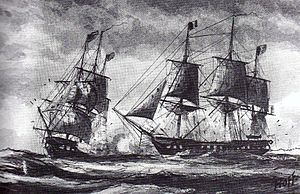USS Insurgent
 Naval encounter during the Quasi-War between USS Constellation and French ship L'Insurgente (right) on 9 February 1799
| |
| History | |
|---|---|
| Name | L'Insurgente |
| Ordered | 3 September 1790 |
| Builder | Pierre-Joseph Pénétreau, Lorient |
| Laid down | 5 November 1791 |
| Launched | 27 April 1793 |
| Captured | by USS Constellation, 9 February 1799 |
| Name | USS Insurgent |
| Acquired | 9 February 1799 |
| Commissioned | August 1799 |
| Fate | Lost at sea, probably foundered September 1800 |
| General characteristics | |
| Type | Sémillante-class frigate |
| Tons burthen | 600 (bm) |
| Length | 45.5 m (149 ft 3 in) |
| Beam | 11.5 m (37 ft 9 in) |
| Draft | 5.5 m (18 ft 1 in) |
| Complement |
|
| Armament |
|
L'Insurgente was a 40-gun
French frigate L'Insurgente
L'Insurgente was built by Pierre-Joseph Pénétreau at Lorient and launched on 27 April 1793.[1]
In January or February 1794, L'Insurgente captured Ann off
On 16 January 1794 L'Insurgente captured the American ship John and James and brought her into Brest. John and James had been built at Philadelphia for George Morrison of Petersburg, Virginia. She had left Petersburg with 450 hogsheads of tobacco and 12,000 staves. On 27 December 1794 the Tribunal of Commerce ordered John and James released to Captain James Johnson and the Committee of Public Safety awarded him a payment of 20,000 livres tournois.[5]
On 25 April L'Insurgente captured Freundschaft Lourentz, Colandt, master, as Freundschaft Lourentz was sailing from Lisbon to London. However two "Scilly boats" (i.e., boats from the Isles of Scilly), recaptured her the next day and brought her into St Ives, Cornwall.[6]
On 5 December 1797 Insurgente captured Prince Frederick as Prince Frederick was returning from Madras and Bengal. Prince Frederick was so badly damaged in the engagement that she sank soon afterwards. Her people, however, were saved.[7] The EIC put a value of £59,981 on the cargo that it had lost.[8]
US-French
Battle with Constellation
On 9 February 1799, after being at sea for three days,
There were no handcuffs to be found and the prisoners seem disposed to rebel. Accordingly, Rodgers placed sentries at the hatch, armed with blunderbusses and under orders to open fire should the prisoners attempt to breach the hatch way.[14]

The US Navy considered Insurgent a prize in the
Loss
On 29 April 1800
See also
- List of French sail frigates
- Original six frigates of the United States Navy
- List of ships captured in the 18th century
- Glossary of nautical terms (A-L)
- Glossary of nautical terms (M-Z)
Citations
- ^ a b c d e Demerliac (1996), p.68, No. 421.
- ^ U.S.Navy, DANFS, Insurgent prgh.1
- ^ Toll, 2006 pp. 142–144
- ^ Powell (1930), p. 333.
- ^ Williams (2009), p.204.
- ^ Lloyd's List, no.2608 – accessed 18 September 2015.
- ^ Lloyd's List №2797.
- ^ Reports (1830), Vol. 2, p.979.
- ^ "Naval Documents related to the Quasi-War Between the United States and France Volume 2 Part 1 of 3 Naval Operations November 1798 to March 1799" (PDF). U.S. Government printing office via Imbiblio. Retrieved 9 March 2024.
- ^ Toll, 2006 pp. 115–117
- ^ Toll, 2006 p. 117
- ^ Harrison, 1858 p.156-158
- ^ Toll, 2006 pp.117–119
- ^ Harrison, 1858 p.158
- ^ "Naval Documents related to the Quasi-War Between the United States and France Volume 3 Part 1 of 4 Naval Operations April 1799 to July 1799, April, 1799 Pg. 62" (PDF). U.S. Government printing office via Imbiblio. Retrieved 2 April 2024.
- ^ U.S.Navy, DANFS, Insurgent prgh.2
- ^ U.S.Navy, DANFS, Insurgent prgh.3
References
- Insurgent. DANFS
- Demerliac, Alain (1996) La Marine De Louis XVI: Nomenclature Des Navires Français De 1774 À 1792. (Nice: Éditions OMEGA). ISBN 2-906381-23-3
- Harrison, Henry William (1858). Battlefields and naval exploits of the United States: ... >H. C. Peck & Theo. Bliss, Philadelphia. p. 448.
- Reports from the Select Committee of the House of Commons appointed to enquire into the present state of the affairs of the East India Company, together with the minutes of evidence, an appendix of documents, and a general index, (1830).
- Powell, John Williams Darmer (1930) Bristol privateers and ships of war. (Bristol: J.W. Arrowsmith).
- Toll, Ian W. (2006). Six frigates: the epic history of the founding of the U.S. Navy. W. W. Norton & Company, New York. pp. 592. ISBN 978-0-393-05847-5.
- Williams, Greg. H. (2009) The French Assault on American Shipping, 1793-1813: A History and Comprehensive Record of Merchant Marine Losses. (McFarland). ISBN 978-0-7864-5407-5
